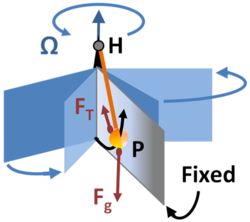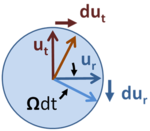Foucault pendulum
 From Citizendium - Reading time: 8 min
From Citizendium - Reading time: 8 min

While the pendulum P swings in a fixed plane about its hanger at H, the planes of the Earth observer rotate. In an inertial frame the bob is subject to two forces: the tension in the wire FT and the force of gravity Fg.
The Foucault pendulum, or Foucault's pendulum, demonstrated in Paris in 1851, is named after the French physicist Léon Foucault. It is a device that demonstrates the rotation of the Earth. According to an inertial observer, the pendulum swings in a plane fixed relative to the "fixed stars", while as observed on Earth this plane appears to rotate. For most pendulums, the effect is masked by other complications, so some care must be taken in constructing a successful pendulum, particularly to insure the hanger exerts no torque upon the pendulum and is immune to wear.[1]
The easiest way to understand the operation is to imagine the pendulum at the North pole, shown in the figure. As the pendulum swings, the Earth rotates and it appears to the Earth-bound observer that every 24 hours the pendulum returns to its initial plane of oscillation.
Approximations and idealizations[edit]
In the inertial frame of reference, the pendulum swings back in forth in a plane. However, at the top of its swing it has zero velocity and the bob is subject to no centrifugal force, while at the bottom of its swing it moves rapidly, and is subject to considerable centrifugal force. Consequently, the tension in the wire varies appreciably if the swing has large amplitude, and the wire will stretch as the bob descends, meaning the orbit is not a circle. That complicates the analysis without adding to any insight into the experiment.
In the rotating Earth frame of reference, the pendulum does not swing in a plane, because the Earth turns during its swing, making the projection onto a horizontal plane of the pendulum's path describe an arc, not a straight line. That introduces further complications for analysis in the Earth frame of reference.
To simplify the analysis and make clear what the experiment is about, the pendulum is idealized as executing very small amplitude swings, such that the bob's change in elevation is negligible, the bob's velocity is low enough that centrifugal force has negligible effect, and the tension in the wire FT has always a magnitude the same as the magnitude of the force of gravity, |Fg|.
Under these circumstances, if we introduce coordinate axes with z the vertical coordinate and x and y coordinates in the horizontal plane, the movement of the pendulum is analyzed entirely in the xy-plane. The problem in the inertial frame becomes one of watching the bob travel back and forth along the same direction parallel to the ground at the North pole, while from the Earth frame, one watches the same thing from a rotating carousel.
Inertial frame[edit]
In the inertial frame the path of the bob is a straight line in the xy-plane. If the origin is taken at the center of the swing, the path is described as:
where ur is a unit magnitude vector pointing along the path of the bob, and r is the radius vector from the origin to the bob. The frequency ω is related to the period T of the swing as:
and one swing occurs as the time ranges between −T/2 and T/2.
The velocity of the bob is then (using a dot notation for time derivatives in the inertial frame):
The net force on the bob is therefore:
At time t =T/2, the radial coordinate is r = Aur and the bob is at its furthest extreme. The tension in the string and gravity combine in a radially inward component, accelerating the bob toward the origin with acceleration A ω2. At time t=0, there is zero net force on the bob, and it travels at maximum speed through the origin.
This net force upon the bob (within the idealizations outlined above) is the resultant of the tension in the wire and the force due to gravity, which both the Earth observer and the inertial observer see as forces acting upon the bob, and both agree upon their measure. However, the Earth observer measures other forces at work as well, as discussed next.
Earth frame[edit]

As time progresses and the unit vectors rotate maintaining unit size, each unit vector's change is orthogonal to it, and therefore parallel to its orthogonal partner.
The Earth coordinate axes rotate with the angular rate Ω of the Earth about the pole. Thus, the unit vector ur is described from Earth at any given time t as:
with i, j unit vectors in the x- and y-directions. In the Earth frame, i and j are time-independent unit vectors, while in the inertial frame it is ur and ut (the unit vector perpendicular to ur introduced below) that are time independent. The time derivative of the unit vector ur is:
where ut is a unit magnitude vector orthogonal to the radial vector ur in the xy-plane. Likewise:
At t=0 the plane of the pendulum is along the x-axis, and at t =T/2 the Earth has rotated counterclockwise by 90°, placing the pendulum along the negative y-direction. Consequently, the path of the bob in the Earth frame is:
The velocity of the bob is:
with vEarth the velocity of the bob in the Earth frame. It can be seen that in the Earth frame the bob does not move strictly along the radial direction ur, but has as well a velocity component at right angles along ut.
The acceleration of the bob is:
Unlike the inertial frame acceleration, which always is in the radial direction, the Earth observer sees a perpendicular component that causes the plane of the pendulum to rotate clockwise (opposite to the Earth's rotation).
This result can be compared with the inertial frame acceleration:
Evidently the Earth observer sees the acceleration of the inertial observer with two additional terms. Multiplying the acceleration by the bob's mass to obtain the forces:
Using the right-hand rule to introduce the vector representing the rotation of the Earth along the z-axis as:
and noting that:
the cross product of the apparent velocity of the bob and the rotation vector is:
whereupon the forces become:
The force on the bob due to wire tension and gravity Fintl must be the same for both observers. But the forces upon the bob seen by the Earth observer supplement the forces from tension and gravity with the centrifugal force observed due to rotation:
and the observed Coriolis force:
where vEarth is the velocity of the bob as seen by the Earth observer. The Coriolis force accounts for the Earth observation of a daily precession of the pendulum's orbit.

Vector cross product used to determine the Coriolis force when the bob is "frozen" at a fixed location in the inertial frame.
If the pendulum is "frozen" at some position r, so the bob does not swing and simply is stationary in the inertial frame, the Earth observer sees the bob execute a circular orbit of radius r, as shown in the figure. The vector Ω×vEarth points outward, and the Coriolis acceleration has twice this value and points inward. The Earth observer sees a net force on the bob of:
which is to say, the Earth observer sees the centripetal force that is demanded by Newton's laws for the apparent circular motion seen from Earth. The centrifugal force, always outward directed, is overcome by the Coriolis force to provide the centripetal force. Thus, the body seen as stationary by the inertial observer and so subject to no force whatsoever, also is seen as requiring no outside agency of centripetal force by the Earth observer because the Coriolis and centrifugal forces look after the matter by themselves.
Other latitudes[edit]
See also the discussion at Coriolis force: Rotating sphere.
If the pendulum is not at the North pole, but at a latitude making angle φ with the horizontal, the axis of rotation is inclined and the rate of rotation of the plane of the pendulum becomes Ω sinφ. Thus, at the equator φ=0 and there is no rotation.[2]
Notes[edit]
- ↑ An account of some of these practical matters is found in AC Longden (April 19, 1919). "On the irregularities of motion of the Foucault pendulum". Physical Review vol. 13 (no. 4): pp. 142 ff. A more modern account is William Tobin (2003). “Appendix D: Building a Foucault pendulum”, The life and science of Léon Foucault: the man who proved the earth rotates. Cambridge University Press, pp. 307 ff. ISBN 0521808553.
- ↑ John Robert Taylor (2005). “§9.9 The Foucault pendulum”, Classical Mechanics. University Science Books, p. 357. ISBN 189138922X.
 KSF
KSF